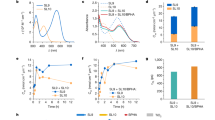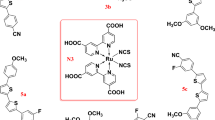Abstract
Solar energy is a promising solution to global energy-related problems because it is clean, inexhaustible and readily available. However, the deployment of conventional photovoltaic cells based on silicon is still limited by cost, so alternative, more cost-effective approaches are sought. Here we report a bifacial dye-sensitized solar cell structure that provides high photo-energy conversion efficiency (∼6%) for incident light striking its front or rear surfaces. The design comprises a highly stable ruthenium dye (Z907Na) in combination with an ionic-liquid electrolyte and a porous TiO2 layer. The inclusion of a SiO2 layer between the electrodes to prevent generation of unwanted back current and optimization of the thickness of the TiO2 layer are responsible for the enhanced performance.
This is a preview of subscription content, access via your institution
Access options
Subscribe to this journal
Receive 12 print issues and online access
$209.00 per year
only $17.42 per issue
Buy this article
- Purchase on Springer Link
- Instant access to full article PDF
Prices may be subject to local taxes which are calculated during checkout




Similar content being viewed by others
References
Mori, H. Radiation energy transducing device. US patent 3,278,811 (1966).
Hübner, A., Aberle, A. G. & Hezel, R. Cost-effective bifacial silicon solar cells with 19% front and 18% rear efficiency. Conf. Proc. 25th PVSC, 13–17 May 1996, 489–492 (IEEE, Washington, DC).
Hübner, A., Aberle, A. G. & Hezel, R. Novel cost-effective bifacial silicon solar cells with 19.4% front and 18.1% rear efficiency. Appl. Phys. Lett. 70, 1008–1010 (1997).
Uematsu, T. et al. Development of bifacial PV cells for new applications of flat-plate modules. Solar Energy Mater. Solar Cells 75, 557–566 (2003).
Khrypunov, G. et al. Recent development in evaporated CdTe solar cells. Solar Energy Mater. Solar Cells 90, 664–677 (2006).
Rostan, P. J. et al. Formation of transparent and ohmic ZnO:Al/MoSe2 contacts for bifacial Cu(In,Ga)Se2 solar cells and tandem structures. Thin Solid Films 480–481, 67–70 (2005).
Nakada, T. et al. Novel device structure for Cu(In,Ga)Se2 thin film solar cells using transparent conducting oxide back and front contacts. Solar Energy 77, 739–747 (2004).
Schermer, J. J. et al. Photon confinement in high-efficiency, thin-film III–V solar cells obtained by epitaxial lift-off. Thin Solid Films 511–512, 645–653 (2006).
O'Regan, B. & Grätzel, M. A low-cost, high-efficiency solar cell based on dye-sensitized colloidal TiO2 films. Nature 353, 737–739 (1991).
Grätzel, M. Photoelectrochemical cells. Nature 414, 338–344 (2001).
Smestad, G., Bignozzi, C. & Arazzi, R. Testing of dye-sensitized solar cells I: Experimental photocurrent output and conversion efficiencies. Solar Energy Mater. Solar Cells 32, 259–272 (1994).
Tsubomura, H., Matsumura, M., Noyamaura, Y. & Amamiya, T. Dye sensitized zinc oxide: Aqueous electrolyte: Platinum photocell. Nature 261, 402–403 (1976).
Matsumura, M. PhD thesis, Osaka University, Japan (1979).
Nazeeruddin, Md. K. et al. Engineering of efficient panchromatic sensitizers for nanocrystalline TiO2-based solar cells. J. Am. Chem. Soc. 123, 1613–1624 (2001).
Chiba, Y. et al. Dye-sensitized solar cells with conversion efficiency of 11.1%. Jpn J. Appl. Phys. 45, L638–L640 (2006).
Wang, Z. S., Yamaguchi, T., Sugihara, H. & Arakawa, H. Significant efficiency improvement of the black dye-sensitized solar cell through protonation of TiO2 films. Langmuir 21, 4272–4276 (2005).
Kuang, D. et al. Stable, high-efficiency ionic-liquid-based mesoscopic dye-sensitized solar cells. Small 3, 2094–2102 (2007).
Ionic Liquids IIIA. Fundamentals, Progress, Challenges and Opportunities: Properties and Structure (eds Rogers, R. D. & Seddon K. R.) (ACS Symposium Series, 2005).
Kang, M. G. et al. A 4.2% efficient flexible dye-sensitized TiO2 solar cell using stainless steel substrate. Solar Energy Mater. Solar Cells 90, 574–581 (2006).
Ito, S. et al. High-efficiency (7.2%) flexible dye-sensitized solar cells with Ti-metal substrate for nanocrystalline-TiO2 photoanode. Chem. Commun. 4004–4006 (2006).
Mohmeyer, N. et al. An efficient organogelator for ionic liquids to prepare stable quasi-solid-state dye-sensitized solar cells. J. Mater. Chem. 16, 2978–2983 (2006).
Kuang, D. et al. High molar extinction coefficient heteroleptic ruthenium complexes for thin film dye-sensitized solar cells. J. Am. Chem. Soc. 128, 4146–4154 (2006).
Kubo, W. et al. Photocurrent-determining processes in quasi-solid-state dye-sensitized solar cells using ionic gel electrolytes. J. Phys. Chem. B 107, 4374–4381 (2003).
Ito, S. et al. High-efficiency organic-dye-sensitized solar cells controlled by nanocrystalline-TiO2 electrode thickness. Adv. Mater. 18, 1202–1205 (2006).
Würfel, U., Wagner, J. & Hinsch, A. Spatial electron distribution and its origin in the nanoporous TiO2 network of a dye solar cell. J. Phys. Chem. B 109, 20444–20448 (2005).
Fabregat-Santiago, F. et al. Influence of electrolyte in transport and recombination in dye-sensitized solar cells studied by impedance spectroscopy. Solar Energy Mater. Solar Cells 87, 117–131 (2005).
Usui, H., Matsui, H., Tanabe, N. & Yanagida, S. Improved dye-sensitized solar cells using ionic nanocomposite gel electrolytes. J. Photochem. Photobiol. A 164, 97–101 (2004).
Berginc, M. et al. Ionic liquid-based electrolyte solidified with SiO2 nanoparticles for dye-sensitized solar cells. Thin Solid Films 516, 4645–4650 (2008).
Kern, R. et al. Modeling and interpretation of electrical impedance spectra of dye solar cells operated under open-circuit conditions. Electrochim. Acta 47, 4213–4225 (2002).
Wang, P. et al. Charge separation and efficient light energy conversion in sensitized mesoscopic solar cells based on binary ionic liquids. J. Am. Chem. Soc. 127, 6850–6856 (2005).
Burnside, S. D. et al. Self-organization of TiO2 nanoparticles in thin films. Chem. Mater. 10, 2419–2425 (1998).
Ito, S. et al. Fabrication of thin film dye sensitized solar cells with solar to electric power conversion efficiency over 10%. Thin Solid Films 516, 4613–4619 (2008).
Ito, S. et al. Calibration of solar simulator for evaluation of dye-sensitized solar cells. Solar Energy Mater. Solar Cells 82, 421–429 (2004).
Ito, S. et al. Photovoltaic characterization of dye-sensitized solar cells: Effect of device masking on conversion efficiency. Progr. Photovol. 14, 589–601 (2006).
Acknowledgements
This work was supported by a grant from the Swiss Federal Energy Office (OFEN). The UV-curing glue and the SiO2 slurry (d = 600 nm) were provided by Three Bond (K. Kishi) and CCIC (T. Mizuno and T. Koyanagi), respectively.
Author information
Authors and Affiliations
Contributions
S.I. fabricated the TiO2 electrodes, TiO2/SiO2 electrodes and platinum electrodes, assembled cells, and performed the measurements for Figs 2–4. S.Z. synthesized the ruthenium dye (Z907) and the ionic liquid. P.C. synthesized the TiO2 nanoparticles. P.L. provided guidance on how to assemble the cells and equipment control. D.K. provided the details of the ionic–ionic liquid information. M.G. provided technical advice.
Corresponding author
Rights and permissions
About this article
Cite this article
Ito, S., Zakeeruddin, S., Comte, P. et al. Bifacial dye-sensitized solar cells based on an ionic liquid electrolyte. Nature Photon 2, 693–698 (2008). https://doi.org/10.1038/nphoton.2008.224
Received:
Accepted:
Published:
Issue Date:
DOI: https://doi.org/10.1038/nphoton.2008.224
This article is cited by
-
Optimization of Pt loading on the counter electrode for efficient and bifacial dye-sensitized solar cells with polymer gel electrolyte
Korean Journal of Chemical Engineering (2022)
-
Semiconductors as Effective Electrodes for Dye Sensitized Solar Cell Applications
Topics in Current Chemistry (2021)
-
Enhanced performance of CdS/CdSe quantum dot-sensitized solar cells by long-persistence phosphors structural layer
Science China Materials (2020)
-
Ultrafast charge separation dynamics in opaque, operational dye-sensitized solar cells revealed by femtosecond diffuse reflectance spectroscopy
Scientific Reports (2016)
-
Tailoring of Energy Levels in D-π-A Organic Dyes via Fluorination of Acceptor Units for Efficient Dye-Sensitized Solar Cells
Scientific Reports (2015)



